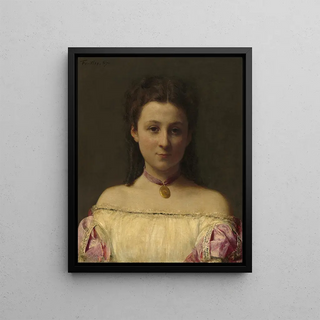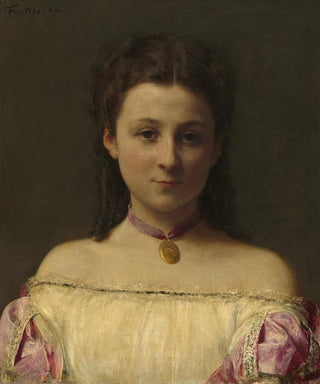Art print | Mademoiselle de Fitz-James - Henri Fantin-Latour


View from behind

Frame (optional)
In the fascinating world of art, some works stand out for their ability to capture the very essence of their era. "Mademoiselle de Fitz-James" by Henri Fantin-Latour is one of these iconic pieces. Painted in 1870, this artwork presents itself as a striking portrait that transcends mere artistic exercise to become a true statement on feminine beauty and elegance. Through this art print, the viewer is invited to delve into the intimate universe of 19th-century French high society, where every detail, every color, and every expression are carefully orchestrated to evoke an atmosphere of refinement and mystery.
Style and uniqueness of the work
Fantin-Latour's style is often associated with delicate realism, where light plays a crucial role. In "Mademoiselle de Fitz-James," the color palette chosen by the artist evokes subtle harmony, highlighting the delicate complexion of the model while creating a contrast with the rich textures of her dress. The composition is marked by a natural, almost nonchalant pose, which confers an aura of sophistication to the female figure. The meticulous details, such as the nuances of fabrics and the reflections of light, testify to Fantin-Latour's talent in capturing reality with visual poetry. This portrait is not limited to a simple representation; it tells a story, that of a woman rooted in her time, while hinting at a part of mystery that invites contemplation.
The artist and his influence
Henri Fantin-Latour, an artist of the late 19th century, is often recognized for his ability to blend portraiture and still life. Although less known than some of his contemporaries, his work had a significant influence on the development of the Impressionist movement. Fantin-Latour knew how to create works that, while respecting academic traditions, paved the way for bolder experimentation. His ability to incorporate elements of everyday life into his portraits helped redefine the artistic standards of his era. By painting "Mademoiselle de Fitz-James," he does not simply represent

Matte finish

View from behind

Frame (optional)
In the fascinating world of art, some works stand out for their ability to capture the very essence of their era. "Mademoiselle de Fitz-James" by Henri Fantin-Latour is one of these iconic pieces. Painted in 1870, this artwork presents itself as a striking portrait that transcends mere artistic exercise to become a true statement on feminine beauty and elegance. Through this art print, the viewer is invited to delve into the intimate universe of 19th-century French high society, where every detail, every color, and every expression are carefully orchestrated to evoke an atmosphere of refinement and mystery.
Style and uniqueness of the work
Fantin-Latour's style is often associated with delicate realism, where light plays a crucial role. In "Mademoiselle de Fitz-James," the color palette chosen by the artist evokes subtle harmony, highlighting the delicate complexion of the model while creating a contrast with the rich textures of her dress. The composition is marked by a natural, almost nonchalant pose, which confers an aura of sophistication to the female figure. The meticulous details, such as the nuances of fabrics and the reflections of light, testify to Fantin-Latour's talent in capturing reality with visual poetry. This portrait is not limited to a simple representation; it tells a story, that of a woman rooted in her time, while hinting at a part of mystery that invites contemplation.
The artist and his influence
Henri Fantin-Latour, an artist of the late 19th century, is often recognized for his ability to blend portraiture and still life. Although less known than some of his contemporaries, his work had a significant influence on the development of the Impressionist movement. Fantin-Latour knew how to create works that, while respecting academic traditions, paved the way for bolder experimentation. His ability to incorporate elements of everyday life into his portraits helped redefine the artistic standards of his era. By painting "Mademoiselle de Fitz-James," he does not simply represent






